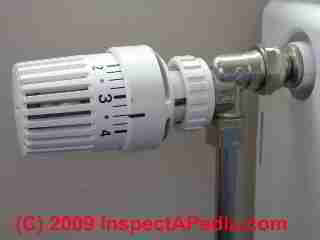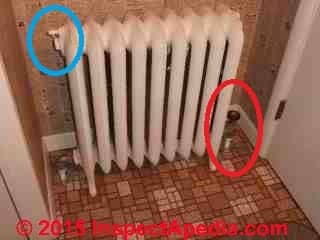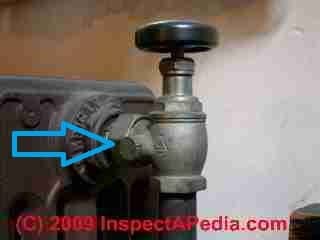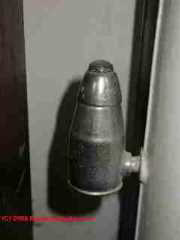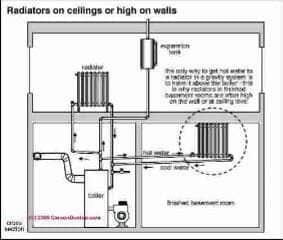 Fix Cold Hot Water Heat Radiators, Baseboards & Convectors
Fix Cold Hot Water Heat Radiators, Baseboards & Convectors
- POST a QUESTION or COMMENT about troubleshooting cold hydronic (hot water) heating radiators, convectors, baseboards on hot water heating systems
Troubleshoot cold radiators, baseboards, convectors in hot water heating systems: this article describes the diagnosis & repair of cold "hot water" heating baseboards, convectors, radiators, or "hot water" radiators.
This website provides articles that help in diagnosing and repairing no-heat problems with each types of hot water or steam or fan convector heat delivery systems.
InspectAPedia tolerates no conflicts of interest. We have no relationship with advertisers, products, or services discussed at this website.
What to Check First if your Radiator, Baseboard, or Convector is Not Getting Hot
First let's be sure we're reading the best cold-radiator diagnostic advice for your situation.
This article will help you fix a hot water heating system (hydronic) radiator that is not heating up as it should.
If your heating system runs on hot water (it's a hydronic heating system) but it uses those skinny horizontal baseboards instead of radiators, you will be happier if you
see BASEBOARD HEAT for cold baseboard diagnosis and repair.
If your heating system uses steam radiators or steam convectors see COLD STEAM HEAT RADIATORS for help in diagnosing and fixing steam radiators that won't get hot.
[Click to enlarge any image]
Our page top heating system illustration and the sketch at left were provided compliments of Carson Dunlop Associates, a Toronto home inspection, education & report writing tool company [ carsondunlop.com ].
If none of your heating radiators, baseboards, etc. are getting hot,
start your diagnosis of the problem
at NO HEAT - BOILER / FURNACE DIAGNOSIS. It may be that your boiler is simply not running, has lost power, is switched off, or that the thermostat is not calling for heat.
If you have heat in some areas but not others
we discuss diagnosing baseboard heat problems below, followed by a discussion of radiators and convector unit problems for both hot water and steam heat.
Below we'll
give FIVE QUICK STEPS you can try to diagnose why your heating radiator(s) or baseboard(s) are not getting hot, followed by a
more DETAILED COLD BASEBOARD / RADIATOR DIAGNOSIS
5 Steps to Fix a Heating Baseboard or Radiator that Does Not Get Hot
- Make sure that your room thermostat is set
to a temperature higher than the temperature in the room - so that it is calling for heat.
But if you're sure your thermostat is calling for heat, continue below.
See THERMOSTATS, HEATING / COOLING if you need help with that device. - Zone Valves:
if your room thermostat controls a zone valve make sure that the zone valve motor operates and that the zone valve opens; note that some hot water heating systems use one circulator feeding multiple zones controlled by individual thermostats and zone valves while other hot water heating systems may use multiple circulator pumps, one per heating zone.
If you're sure your zone valve is open (or there are no zone valves), continue below.
Otherwise see ZONE VALVES, HEATING for details. - Check that the circulator pump(s)
are running;
If the circulator is running the pipes before and after the circulator should be hot. If so, continue below.
See CIRCULATOR PUMPS & RELAYS for details. - Make sure that your heating boiler is working,
that is that the heating boiler turns on and off normally. A hot water heating boiler may not turn on immediately when you turn up the room thermostat:
if the water temperature in the boiler is already above the aquastat's cut-in temperature the circulators will send hot water to the radiator and the boiler will turn on later when its temperature is dropped by returning water from the cooler radiators in the building.
When the boiler temperature falls below the aquastat's cut-in temperature the boiler should run. If it does, continue below.
Or see NO HEAT - BOILER - Check for an air-bound
heating line or baseboard segment if the baseboard never gets hot.
See AIR-BOUND HEATING SYSTEMS
You may also need to see AIR BLEEDER VALVES and if you need to add bleeder valves
See AIR BLEED VALVE INSTALLATION - Check for dirt or dust clogging
the finned tubing of baseboard heaters that use that component (photo at above-left) or check for air flow blockage at the bottom opening (cool air inflow) and top opening (warm air outflow) at the baseboards if the actual baseboard piping gets hot but not enough heat comes into the room.
What follows below is a more-detailed look at these no heat diagnostic steps.
Guide to Diagnosing Cold Hydronic (hot water) Radiators in Buildings
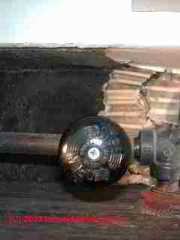 If your heat is provided by individual hot water radiators or convector units, usually there is a control valve at each radiator or convector. Make sure that the control valve at the heating radiator is "open" or "on".
If your heat is provided by individual hot water radiators or convector units, usually there is a control valve at each radiator or convector. Make sure that the control valve at the heating radiator is "open" or "on".
In the "cold radiator" diagnosis article below we include links to additional detailed articles that will help you correct a problem with heating baseboards or radiators that are not working:
Check the radiator control valve:
If a radiator is not getting hot: (steam or hot water) first see if the valve that controls it has been turned off. Try turning the valve counter-clockwise to see if it will open. See details
at RADIATOR VALVES & HEAT CONTROLS.
In our photo (left), the heating convector control valve was found at floor-level under the heating convector. The "open" and "close" directions for this "radiator valve" were nicely marked by the manufacturer (click to enlarge the photo).
If the radiator valve does not turn in that direction, try turning it in the other direction (clockwise or "closed") to see if the radiator valve is stuck. You may also find the same control valve at heating convectors (but not usually at heating baseboards).
While people sometimes turn off radiators in an un-used portion of a building we usually find that they have been left "on" - in fact turning off a hot radiator in some building areas could lead to its freezing and cracking. Steam radiators, on the other hand, can usually be turned-off with impunity since steam radiators do not normally contain water in its liquid form. [That's true at least so long as condensate has not become trapped inside of the steam radiator.]
Watch out: don't use excessive force to try to turn a "stuck" radiator valve. First, you may be trying to open a valve that is already in its fully-open position.
Second, the valve may actually be jammed. Excessive force can break the valve or even cause a leak. If the valve won't turn at all counter-clockwise towards "open", try turning it the other way - clockwise, towards "closed". If the valve now turns you'll know it was already in its open position.
Thermostatically controlled radiator valves:
If you have to replace the control valve on a hot water or steam radiator or convector unit, consider installing a new valve that incorporates a thermostat as well, such as the automatic radiator valve shown at above left.
This (more expensive) radiator control valve lets you treat each individual radiator as a "heating zone". As long as the thermostat is calling for heat, each radiator can be regulated automatically.
If only some of your hot water radiators, hot water heating convector units, or hot water baseboard heating sections are not getting hot
and the radiator valve is open (turned counter-clockwise - the red circle in our photo at left) then you may need to bleed air out of the radiator so that hot water from the boiler can flow into the radiator.
Many hot radiators have an air bleeder valve (blule circle in our photo at above left) that the homeowner can operate if she takes care about scalding risks and avoids making a mess by bleeding just air, not water.
See AIRBOUND HEAT SYSTEM REPAIR
In our photo at above right you can see not only the radiator control valve, but more: we can conclude that this is a hot water heating system, not a steam heat system because there is no automagic air vent that we find on steam radiators, and second, the radiator control valve includes an air bleeder - that nut on the side of the valve body (blue arrow, photo above right).
In looking for an air bleeder in our article on this procedure
at BLEEDER VALVES it's easy to miss this particular air bleeding device.
Watch Out: even if the radiator valve appears to be "open" - that is, turned fully counter-clockwise (red circle in the photo at above left), if the valve is broken internally you may be just turning the knob but the valve may be staying closed inside.
Usually while turning a radiator valve to from "closed" to "open" position, if you look closely at the valve stem - the metal rod or shaft extending below the knob you are holding, and extending into the body of the valve itself - you'll see that as you "open" the valve the stem gets "longer" and often a less-oxidized, shiner part of the valve will become exposed as it moves upwards from having been inside the valve body.
That's a great way to convince yourself that yes, the valve is probably opening internally too, you're not just turning the knob.
If the valve body has broken loose from the valve stem, that's an internal problem you can't see, but turning the radiator valve knob, even if it rotates, will not open a broken, stuck, frozen valve.
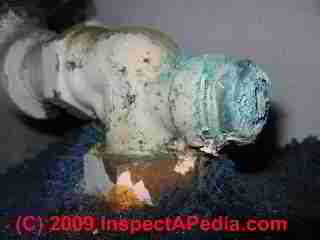 On a heating convector unit there is usually an individual hot water flow control valve
On a heating convector unit there is usually an individual hot water flow control valve
that lets the unit be turned down or off - but as our photo (left) shows, the valve can be a little harder to spot.
Unlike a radiator valve, a heating convector control valve may be hidden by the convector's steel cover, or it may be little and hard to recognize as we show here.
This valve, if it's not jammed by corrosion, is operated by a screw driver; it may be possible to get this valve working by gently loosening the lock-nut and then turning the control screw with a flat-bladed screwdriver.
Do not take apart this valve while the heating system is on and hot - you risk getting sprayed with hot water or you may start a leak that's hard to stop without making a mess and having to shut down the whole heating system.
Note that a hot water heating convector will also usually have its own personal air bleeder valve too - typically at the opposite end of the convector from the water feed valve.
How to Bleed Radiators of Trapped Air
If just some of your hot water radiators are not getting hot you may just need to bleed or remove air from the "cold" hot water radiator, baseboard, or heating convector unit,
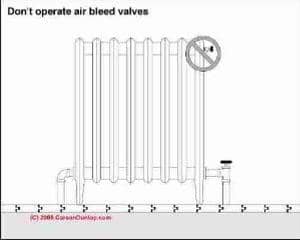 see AIR BLEEDER VALVES.
see AIR BLEEDER VALVES.
Carson Dunlop Associates' sketch (left) shows a common location for the air bleed valve on a cast iron radiator.
The advice to leave this valve alone is intended for home inspectors who don't want to risk spilling water on someone's floor or opening a valve to find that they can't close it again.
See AIR BLEEDER VALVES for details about how to get an individual cold radiator working again if it's air bound, and
see AIRBOUND HEAT SYSTEM REPAIR if the cold radiator, convector, or baseboard problem seems to affect all of the heating radiation devices on all or part of an individual heating piping loop or zone.
Since on many hot water heating systems a key air bleeding or air vent point is at the air scoop or air separator closer to the boiler,
see AIR SCOOPS SEPARATORS PURGERS.
Hot water heating boilers, their inspection, diagnosis, and repair are discussed beginning
at BOILERS, HEATING.
Guide to Fixing Cold Steam Radiators: Steam Vents & Radiator Slope
 If your heating system uses steam radiators or steam convectors see
If your heating system uses steam radiators or steam convectors see
COLD STEAM HEAT RADIATORS for help in diagnosing and fixing steam radiators that won't get hot. Excerpts from that article are found below.
Make sure that your room thermostat is set to a temperature higher than the temperature in the room - so that it is calling for heat.
Make sure that your heating boiler is working, that is that the heating boiler turns on and off normally. A steam boiler will usually turn on right away in response to the thermostat being turned up or on a call for heat.
Make sure that the control valve at the heating radiator is "open" or "on" as we describe just below. Details are
at RADIATOR VALVES & HEAT CONTROLS.
First check the radiator valve.
At Guide to Diagnosing Cold Radiators in buildings we illustrated different types of heating radiator control valves and explained their operation.
It's standard to ask first "is the radiator valve turned on or "open" (fully counter-clockwise)?
But other problems can cause a steam heat radiator to stay cold when you want heat. Here is diagnostic and repair advice.
If some of your steam heat radiators are not getting hot, the steam vent may not be working.
If a steam radiator valve is open but the radiator is still cold, the steam vent may not be working. Our photo (above right) shows a typical steam radiator vent.
When steam is first rising in the heating system, the steam heating radiator will be cool as will be the steam vent.
The vent opens, allowing rising steam to enter the radiator by pushing air out through the vent.
When the steam radiator and steam vent are warm or hot, the vent closes. If a steam vent stops working, rising steam cannot enter the radiator and it will be slow to heat or may not heat at all.
See STEAM VENTS and
also STEAM HEATING SYSTEMS for details.
Steam radiator sloped the wrong way - steam condensate blockage
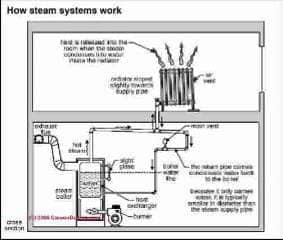 As our Carson Dunlop Associates sketch shows (below, left), steam radiators can be sensitive to exactly how they are installed and pitched or sloped.
As our Carson Dunlop Associates sketch shows (below, left), steam radiators can be sensitive to exactly how they are installed and pitched or sloped.
You'll want to learn if your steam heating system is a "one pipe" or a "two pipe" design, but in either case, if the steam supply or condensate return piping have been moved or settled so as to have lost the proper slope, correcting those conditions may be needed.
[Click to enlarge any image]
That's because condensate, produced by cooling steam in the radiator, has to be able to drain back out of the radiator.
A steam radiator that is sloped the wrong way, perhaps due to building floor settlement or a change made by an inexperienced remodeler, will become partly or even completely blocked by accumulated condensate, leading to loss of heat.
This article series answers most questions about all types of heating systems and gives important inspection, safety, and repair advice.
Reader Q&A - also see the FAQs series linked below
On 2019-10-17 - by (mod) -
Not sure Phil, can you attach a photo or several (one per comment) ?
Most hot water rads are fed from the bottom so that any air can be bled out of an air bleeder at the top - but you may have an exception.
Most steam radiators (two pipe rads) are fed from the top (with a few exceptions);
On 2019-10-17 by Phil
I have a cast iron radiator with scopes for the hot water pick up. The radiator has one pipe at the bottom and another is at the top. Which one does the flow of water go into high or low
On 2019-10-14 - by (mod) -
Check the article above and the article index for AIRBOUND RADIATORS - you're on the right track but you may need more pressure or you may need to open high air bleeders somewhere you've missed.
Of course you checked that the zone valves are open or circulator's running, right?
On 2019-10-13 by debbie
I changed my hot water holding tank on my boiler. Now that I've reconnected the pipes 2 of my 3 zones aren't producing heat. I replaced the pump. I have an indoor boiler and out door boiler running they work the same system. I've ran a water hose on the valves 20 minutes each zone to make sure I don't have an airlock. also bled all the radiators. I'm at a loss.
On 2019-01-22 by Devon
The rads in my home are the one pipe style with a valve attached to the pipe coming out of the floor into the rad, as well as a bleeder.
There is one rad that is constantly making a high pitched noise somewhat like an ambulance siren but not as loud, just loud enough to be annoying and interfere with sleep. It has been bled on several occasions, usually only water comes out, and does not make the usual noise of gurgling water or hissing.
Would anyone know what the cause of the noise would be?
On 2019-01-06 - by (mod) -
Mark:
You can either replace the whole pump assembly or you can remove the pump and take it to your local heating or plumbing supplier to see if they have a replacement impeller assembly.
On 2019-01-04 by Mark wilbanks
My pump stop working the pump is working but the part that pumps the water thru the pipes is stuck or frozen how an where do I get the parts to fix it
On 2018-12-18 - by (mod) -
When a gas burner won't ignite the problem could be in the gas valve, or there could be a flue gas spill switch sensor that has tripped and needs to be reset.
On 2018-12-16 by Gail
Pilot is lit, pressure at 13psi.. burner won't ignite and thermostat is turned up
On 2015-02-10 b (mod) - common cold radiator cause when thermostat is calling for heat and the boiler runs and other radiators are hot
Kelly did you look through the Cold Radiator suggestions in the article above? Those offer more detail than I can re-type here.
The common possibilities provided the thermostat is calling for heat and the boiler runs and other radiators are hot are
- radiator valve is closed
- radiator is air-bound
- heating piping to the radiator is air bound
On 2015-02-09 by Kelly
Sorry, we just moved in and have been dealing with electric heat, so this is totally different.
One radiator in our house is not warming like the others. They are all cast iron and run by fuel oil (as far as I know). How or can I adjust it to make heat come out? I have a "key" but when I turn it water comes out. Is that normal?
On 2014-06-04 - by (mod) -
Anon
Usually cast iron baseboard sits right on the floor, providing air intake openings cast into the lower portion of the assembly.
Check the installation instructions included with the units.
On 2014-06-02 by Anonymous
I forgot to state that the space we are looking for is on the bottom of the radiators. Thank you.
On 2014-06-02 by Anonymous
We are installing new tile in our kitchen. We have baseboard cast iron hot water radiators. How much space should we leave in front of the radiators for air circulation? Is a half inch enough? Can it be less? These are mounted on inside walls. Thank you.
On 2014-04-05 - by (mod) -
When you can't get steam to enter a radiator some further diagnosis is in order.
In the More Reading links just above check out the article titled
COLD STEAM HEAT RADIATORS
and comment or email us if questions remain.
On 2014-04-05 by Brooklyn
We have a steam radiator that won't heat up fully unless the heat cycle is long/pressure high.
We tested by removing air valve and running normal and extended cycle. No steam passage under normal cycle. Under extended cycle/increased pressure, steam pouring out of air valve hole.
On 2014-02-24 - by (mod) -
Nytes:
It's usually pretty easy to diagnose a heat-won't turn off problem by disconnecting the thermostat at the control.
If you search InspectApedia or see our ARTICLE INDEX to find "HEAT WON'T TURN OFF" you'll find a diagnostic procedure that ought to help
On 2014-02-24 by Nytes
We have a 3 zone Bryant gas baseboard heater.
Zone 1 (kitchen/dining and 1 bathroom) temp regulates just fine, but zone 2 & 3 will not stop heating when told. Would this be the wall thermostats fault, or is the issue on the furnace itself? We still get excellent water pressure and hot water from our faucets, by the way.
...
Continue reading at AIRBOUND HEAT SYSTEM REPAIR or select a topic from the closely-related articles below, or see the complete ARTICLE INDEX.
Or see COLD HOT WATER BASEBOARD / RADIATOR FAQs - questions and answers about fixing cold radiators, posted originally on this page.
Or see these
Recommended Articles
- AIR BLEEDER VALVES - find and operate those cute little controls on baseboards (or radiators)
- AIRBOUND HEAT SYSTEM REPAIR - most-common problem for cold radiators or baseboards or convectors on hot water heating systems
- BASEBOARD HEAT
- BLEEDER VALVES
- COLD HEATING BASEBOARD / RADIATOR REPAIR
- COLD STEAM HEAT RADIATORS
- NO HEAT - BOILER / FURNACE DIAGNOSIS If none of your heating radiators, baseboards, etc. are getting hot, start your diagnosis at this article
- RADIATOR VALVES & HEAT CONTROLS
Suggested citation for this web page
COLD HEATING BASEBOARD / RADIATOR REPAIR at InspectApedia.com - online encyclopedia of building & environmental inspection, testing, diagnosis, repair, & problem prevention advice.
Or see this
INDEX to RELATED ARTICLES: ARTICLE INDEX to HEATING RADIATORS
Or use the SEARCH BOX found below to Ask a Question or Search InspectApedia
Ask a Question or Search InspectApedia
Try the search box just below, or if you prefer, post a question or comment in the Comments box below and we will respond promptly.
Search the InspectApedia website
Note: appearance of your Comment below may be delayed: if your comment contains an image, photograph, web link, or text that looks to the software as if it might be a web link, your posting will appear after it has been approved by a moderator. Apologies for the delay.
Only one image can be added per comment but you can post as many comments, and therefore images, as you like.
You will not receive a notification when a response to your question has been posted.
Please bookmark this page to make it easy for you to check back for our response.
Our Comment Box is provided by Countable Web Productions countable.ca
Citations & References
In addition to any citations in the article above, a full list is available on request.
- Mark Cramer Inspection Services Mark Cramer, Tampa Florida, Mr. Cramer is a past president of ASHI, the American Society of Home Inspectors and is a Florida home inspector and home inspection educator. Mr. Cramer serves on the ASHI Home Inspection Standards. Contact Mark Cramer at: 727-595-4211 mark@BestTampaInspector.com
- John Cranor [Website: /www.house-whisperer.com ] is an ASHI member and a home inspector (The House Whisperer) is located in Glen Allen, VA 23060. He is also a contributor to InspectApedia.com in several technical areas such as plumbing and appliances (dryer vents). Contact Mr. Cranor at 804-873-8534 or by Email: johncranor@verizon.net
- "Residential Hydronic (circulating hot water) Heating Systems", Instructional Technologies Institute, Inc., 145 "D" Grassy Plain St., Bethel, CT 06801 800/227-1663 [home inspection training material] 1987
- Boilers, Boiler Conversions, James E. Brumbaugh, ISBN 0-672-23389-4 (v. 1) Volume II, Oil, Gas, and Coal Burners, Controls, Ducts, Piping, Valves, James E. Brumbaugh, ISBN 0-672-23390-7 (v. 2) Volume III, Radiant Heating, Water Heaters, Ventilation, Air Conditioning, Heat Pumps, Air Cleaners, James E. Brumbaugh, ISBN 0-672-23383-5 (v. 3) or ISBN 0-672-23380-0 (set) Special Sales Director, Macmillan Publishing Co., 866 Third Ave., New York, NY 10022. Macmillan Publishing Co., NY
- Installation Guide for Residential Hydronic Heating Systems
- Installation Guide #200, The Hydronics Institute, 35 Russo Place, Berkeley Heights, NJ 07922
- In addition to citations & references found in this article, see the research citations given at the end of the related articles found at our suggested
CONTINUE READING or RECOMMENDED ARTICLES.
- Carson, Dunlop & Associates Ltd., 120 Carlton Street Suite 407, Toronto ON M5A 4K2. Tel: (416) 964-9415 1-800-268-7070 Email: info@carsondunlop.com. Alan Carson is a past president of ASHI, the American Society of Home Inspectors.
Thanks to Alan Carson and Bob Dunlop, for permission for InspectAPedia to use text excerpts from The HOME REFERENCE BOOK - the Encyclopedia of Homes and to use illustrations from The ILLUSTRATED HOME .
Carson Dunlop Associates provides extensive home inspection education and report writing material. In gratitude we provide links to tsome Carson Dunlop Associates products and services.


